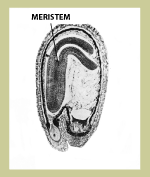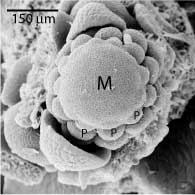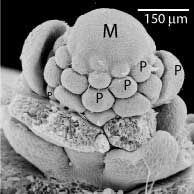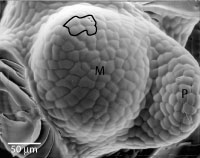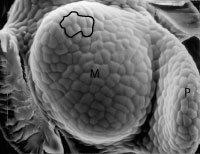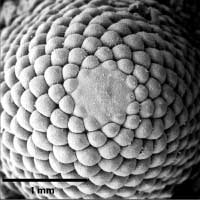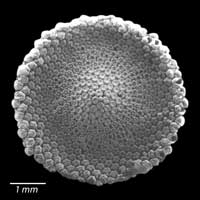





How
Plants Grow - Electron
Micrographs of Meristems - How
Do Primordia Form ? Microscopic Formation of Plant PatternsSpiral and other phyllotactic patterns are most regular at their inception, which occurs at the shoot apical meristem, the growing tip of the plant. Botanical units such as leaves and petals are generated there. At this early stage, they are just bulges of fast growing cells known as primordia. We review here some basic facts about this process. |
|||||
|
|
How Plants Grow |
||||
|
The shoot meristem is present at the tip of the plant embryo, which is contained within the seed. The dome shaped meristem has many rapidly dividing cells. Right: Microscopic image of a seed cross section (1 mm ) showing the minuscule meristem.
|
|
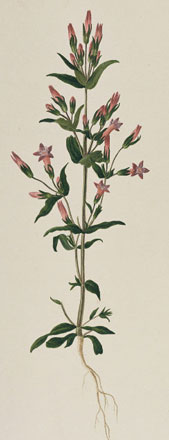 |
|||
| Leaves initiate at the periphery of the meristem. As the plant grows, the meristem moves upward leaving behind previously formed leaves. The leaves continue to grow to their final size, which is why there is a progression of leaf sizes from the top to the bottom of each stem. Branching occurs when additional shoot meristems form where leaves join the stem. |
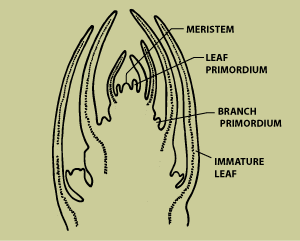 |
||||
How Do Primordia Form?
|
|
|||
Botanists do not quite know what processes regulate the formation of primordia. The two leading models are of reaction-diffusion (biochemical) and buckling (biomechanical). Reaction-Diffusion involves chemical reaction and diffusion of a mixture of chemicals which, under certain conditions, result in non-homogeneous spatial concentrations of the different chemicals - and hence patterns. Reinhardt et. al. (2000) showed that the hormone auxin has a role in the formation and positioning of primordia, an evidence pointing to chemical regulation of the pattern formation. [That reaction-diffusion can lead to non-homogeneous concentration was first proven mathematically in 1952 by the mathematician/computer scientist Turing using Partial Differential Equations. It was later confirmed in several actual chemical reactions, notably the so-called BZ Reaction.] Buckling involves two layers of cells at the tip of a plant: the corpus, or center of the stem, and the tunica, or outer layer. The botanist J. Green proposed that the tunica, as it grows faster than the corpus, buckles (similarly to the skin on fingers after a prolonged bath). As with reaction-diffusion, the mathematical modeling of this phenomenon involves systems of partial differential equations. Using stress analysis of incisions of growing heads of sunflower, Dumais and Steele (2000) give some supporting evidence for buckling. Experiments were apparently less conclusive in some other plants (Snow and R. Snow, 1951).
How Plants Grow - Electron Micrographs of Meristems - How Do Primordia Form ? |
||||

